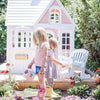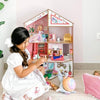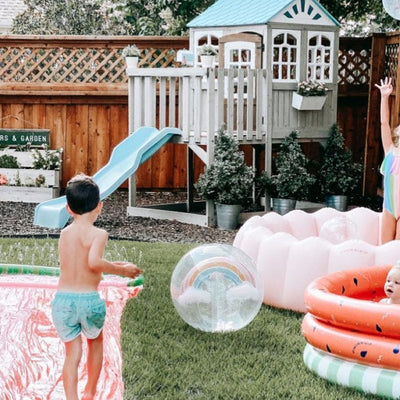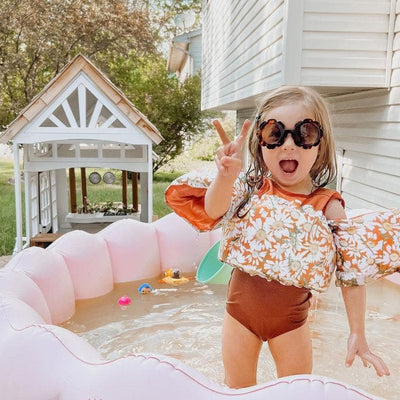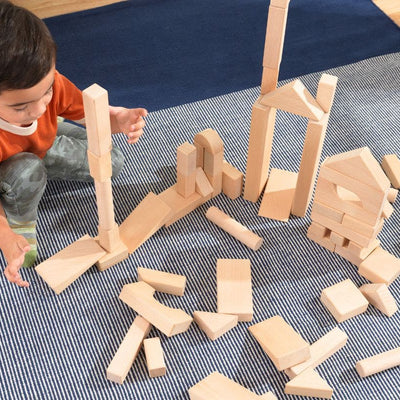Creating a Safe and Fun Outdoor Play Area for Children

Have you come across the 1000 Hours Outside movement on your social media feed yet? It’s a mom-led mission to get our kids outdoors and playing as much as possible, and it’s sparking a passion in parents and caregivers everywhere for the benefits of outdoor play. Even for those of us starting with much less ambitious goals (1000 hours per year can sound intimidating at first!), it’s hard not to be inspired by all the benefits of nature, risk-taking play, and outdoor time for our kids.
That’s why we’re passionate about making backyards as fun and kid-friendly as possible. Because, let’s be honest, nature trails and parks are awesome, but loading kids in the car is hard. To make those outdoor hours a little more attainable, here are some ways you can empower them to play and explore safely in their own backyard!
Safety First
Yes, risk-taking play is critical for kids, but we do want to make sure those are reasonable and purposeful risks. (More on that below!) So it’s our job to protect them from the serious dangers. Before you let the kids loose in the yard, you’ll want to:
- Identify and remove potential hazards. Think rusty nails, gaps in fences, hidden holes, etc.
- Discuss or remove natural hazards. There is something to be learned from a wasp’s nest, a bed of ants, or a patch of thorny plants. If your child is old enough, you can talk to them about staying away from these hazards but still let them observe them from a safe distance. If your child can’t understand or doesn't have the self control for that yet, it’s best to remove the hazards altogether.
- Properly install and maintain outdoor play equipment. Play equipment is ideal for risk-taking play but only if it’s properly installed (i.e. anchored to the ground on a flat surface and surrounded by a safety zone of loose-fill like wood chips).
- Supervise and set rules as needed. Child-led free play doesn’t mean no boundaries. Be sure to set clear rules where necessary and keep the kids within sight.
Encouraging Active Play
One of the greatest benefits of time in the great outdoors is that it nearly always results in active play. All that activity helps kids develop gross motor skills and get the exercise their bodies need, but the benefits don’t end there. Adequate active play is even linked to improved focus, sleep, and emotional regulation.
Kids don’t need much to engage in active play – just a little space and a few well-chosen toys. Balls, frisbees, hula hoops, jump ropes, and similar toys are great budget-friendly options, and larger outdoor toys like swing sets and climbing walls provide a wider range of activities. Don’t forget that nature comes with its own “toys” for active play – digging in the dirt, collecting sticks, and splashing in puddles are all classic kid favorites.
Nurturing Imagination and Creativity
Without getting too sappy here, there is something magical about kids’ natural sense of awe in nature. When they marvel at a feather, dandelion, snail, birds’ nest, cloud, you name it, they’re fueling their imagination with curiosity and wonder. So as you play outdoors, help them slow down occasionally and notice the small stuff. They’ll love learning about it, and they’ll love incorporating these natural elements into their imaginative play.
A few select outdoor toys, like a playhouse, gardening tools, a sandbox, a bug collecting kit, can fuel their exploration and imaginative play as well, naturally encouraging them to want to spend more time outdoors.
Providing Opportunities for Socialization
Ever notice how your kids can spend endless hours outside as long as they’re playing with peers? Hosting outdoor play dates helps your kids get all the benefits of active play, nature play, and social play at once. Outdoor play time is more likely to result in child-led free play (vs. the more parent-led activities that tend to happen indoors), letting kids practice their social skills as they make up their own games and activities.
Balancing Risk and Safety
We mentioned earlier that risk-taking play is so important but that risks should be reasonable and purposeful. So what do we mean by that? First off, reasonable risks are risks that may result in minor injury but not serious or life-threatening harm. So falling just a couple of feet from the low tree branch they were hanging on? Reasonable (depending on their age and physical health, of course). Falling from great heights or swimming unsupervised? Definitely not. As you help your kids stay safe, it’s important to use your own judgment while still giving them room to explore, take risks, and yes maybe incur a few bumps and bruises along the way.
Next, purposeful risks are those that actually help your child learn, gain new skills, and develop confidence and self-regulation. So when kids see how far they can jump from the swing or if they can go down the slide backwards? They’re testing the boundaries of their own coordination and learning how to self-regulate. But when they run into a busy street or step on a rusty nail? There’s not a lot of purpose there (not to mention potential for significant harm), so feel free to completely remove those risks from the play space without feeling like you’re depriving your child of an opportunity for risk-taking play.
The takeaways
Outdoor play gets kids moving, helps spark their curiosity and imagination, and provides opportunities for social skill development and risk-taking play. And there’s no better way to build more outdoor time into your daily rhythms than by making your own backyard safe, fun, and kid-friendly.
KidKraft’s line of outdoor toys and play equipment are designed to do just that. Shop our play sets, playhouses, climbers, sandboxes, and more, and start racking up those outdoor hours… You may just find that 1000 hours outside doesn’t sound so crazy after all!

